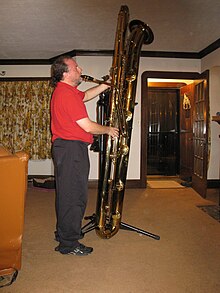 | |
| Woodwind instrument | |
|---|---|
| Classification | Single-reed |
| Hornbostel–Sachs classification | 422.212-71 (Single-reed aerophone with keys) |
| Inventor(s) | Adolphe Sax |
| Developed | Conceived as part of Sax's 1846 patent; first playable instrument built by J'Élle Stainer in 2010 |
| Playing range | |
 | |
| Related instruments | |
|
Sizes:
Orchestral saxophones: Specialty saxophones: | |
| Musicians | |
| |
| Builders | |
| |
The subcontrabass saxophone is the largest of the family of saxophones that Adolphe Sax described in his 1846 patent. He called it the saxophone bourdon, named after the very low-pitched 32′ bourdon pedal stop on large pipe organs. Although Sax planned to build one, the first playable instrument was only built in 2010. It is a transposing instrument pitched in B♭ one octave below the bass saxophone, two octaves below the tenor, and three octaves and a major second below its written pitch.[1]
- ^ Berni, Attilio (21 February 2013). "J'Elle Stainer Double Bb Sub-contrabass Saxophone". saxophone.org. Archived from the original on 22 November 2022. Retrieved 22 November 2022.